From the colourful and bustling barriosof Buenos Aires to the breathtaking Andes Mountain Range in north, Argentina has no shortage of sightseeing opportunities. Boasting a plethora of different habitats and environments to explore, it would take visitors a good few months to see everything this South American gem has to offer.The northern regions of the country offer an exciting blend of colonial heritage, natural beauty and an indigenous flavour, while the spectacular Iguazu Falls, surrounded by the lush forest of the Iguazu National Park, are a must see. Enjoy a day of wine tasting in Mendoza, or head west towards the Chilean border and marvel at the Andes Mountain Range. The curious mix of desert, snow-capped mountains, sandy beaches and majestic glaciers in the Patagonia region is extraordinary, and the world's southern-most city, Ushuaia, nestled on the Tierra del Fuego archipelago, is a departure point for those keen on a trip to Antarctica and also offers some of the best brown trout fishing in the world.The sights and sounds of Buenos Aires are a major draw for many. Stroll along the tree-lined parks and boulevards, visit Evita Peron's grave at La Recoleta Cemetery, explore La Boca, the city's most popular barrio, and take in the Latin American flair by enjoying a romantic night of tango.Buses are the most cost effective way to navigate this impressive country and domestic flights are available at affordable prices. The best time of year to visit Argentina is during the autumn months from March to June when the weather is a little cooler.With so much to see and so little time, it's best you get packing and head off to Argentina for the adventure of a lifetime.
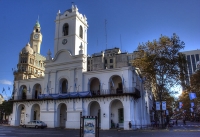
Opposite the Casa Rosada on the Plaza de Mayo is the resplendent former Spanish town hall, the Cabildo, a fascinating old colonial building fronted by arches that once encircled the plaza, back during the May Revolution in 1810. While the building's construction originally began in 1610, it was almost immediately too small. Construction and changes were ongoing well into the 1800's, and the building was finally completed in 1894.The guards outside the building are members of the revered Regimiento de Patricios, which was formed in 1806, and the changing of the guard every hour is a popular attraction. They still wear the traditional uniforms they have donned for nearly 200 years.The interior houses a small museum, which displays some interesting architectural relics, religious icons and watercolour paintings by Enrique Pellegrini, and it is all furnished in colonial period pieces. The views from the Cabildo's windows are some of the best of the Plaza de Mayo. A crafts market is hosted on the back patio on Thursdays and Fridays, from 11am to 6pm.
Address : Calle Bolivar 65
Telephone : +54 11 4342 6729
Opening times : Tuesday to Friday 10am-5pm, Saturday and Sunday 10am-6pm.
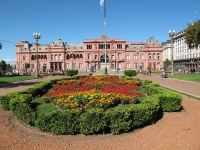
One of the world's most famous balconies juts out of Argentina's Presidential Palace, known as the Casa Rosada. The pink building has been the scene of many a political rally, particularly during the regime of the notorious and tragic Juan and Eva Peron.The building began as a fort in 1594, and was turned into a castle-like centre for colonial government in 1713. Additions and changes were made to the building until 1857, when it was demolished and the Casa Rosada we know today was built. The Italian style building, fronted with palm trees and fountains, was painted pink when it was converted from a Customs and Post Office building into the presidential palace. President Sarmiento decided to appease opposing political parties by merging red and white into a pink colour scheme for the palace.The building has since been declared a National Historic Monument of Argentina. Today the building houses a small basement museum displaying some presidential artefacts. Each evening, a small platoon of mounted grenadiers emerge from the guardhouse to lower the flag on the Plaza, adding a touch of pomp and ceremony to the pretty building.
Address : Hipolito Yrigoyen 219, Plaza de Mayo
Telephone : +54 11 4344 3600
Opening times : Museum: Monday to Friday 10am-6pm, Sundays 2pm-6pm. Guided tours are available.
Admission : Free
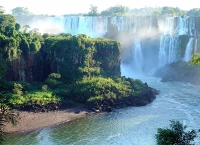
The Iguazú National Park is a huge subtropical rainforest covering 135,000 acres and is home to thousands of different species of flora, fauna and birds, including colourful parrots and hummingbirds. It is most famous for the Iguazú Falls, declared a National Heritage Site by UNESCO. The deep flowing waters of the river tumble down 275 falls, the most famous of which is Devil's Throat. On the border with Brazil, it drops 230ft (70m), almost twice the height of Niagara Falls. As well as enjoying the stunning views from the series of platforms, visitors can enjoy kayaking and other watersports on the river.The Iguazú Falls was one of the locations used for the 1986 film The Missionand, appropriately, Jesuit Mission ruins remain nearby. Iguazú is home to the Guarani people, who sell their handmade crafts inside the park. Some activities available to visitors include a ride on the Ecological Jungle Train, a meal at La Selva Restaurant, and a trip to the San Martin Island at the heart of the falls. Travellers can also enjoy a trek along the Green Trail or Macuco Trail, a walk along the Upper Circuit (the very top of the falls) or the Lower Circuit (the bottom of the falls), and a full moon walk accompanied by national park guides.
Website : www.iguazuargentina.com
Opening times : Daily 8am-6pm.
Admission : ARS330 adults, ARS80 children 6-12 years; other concessions available.
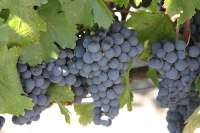
The Mendoza Province rests at the foot of the Andes and is Argentina's main wine-producing region, peppered here and there with wine farms offering tours and tastings. The area is known for its Malbec, and also produces some good Cabernet Sauvignon. The city of Mendoza, a low-rise city since 1861 when it was almost destroyed by an earthquake, is characterised by wide, leafy boulevards and a massive network of canals. Well worth seeing is the Enoteca Giol wine museum and if visiting in late February, don't miss the Fiesta Nacional de la Vendimia, an annual grape-harvest festival accompanied by concerts and local celebrations. Bodega La Rural is one of the biggest wine farms in the area, offering tours that demonstrate the entire wine-making process.Near the border with Chile lies Mount Aconcagua. At 23,000 feet (6,900m), it is the highest mountain in the Western hemisphere. The mountain and its surrounds are wonderful for hiking and mountain climbing, although it's important to note that during low season, tourists are allowed only short hikes for safety reasons. High season starts mid-November. Throughout the year, hiking without an official guide is discouraged, but even driving along the roads surrounding the mountain will give plenty of scenic views. The Mendoza Province is home to La Lenas, one of the biggest and most famous ski resorts in Argentina.
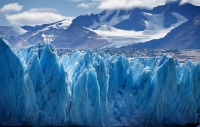
Adventurous travellers are drawn to the savage beauty and rich wildlife of Patagonia. This region of contrasts and extremes, stretching across Argentina and Chile, runs from the Colorado river, south of Buenos Aires, across to the southern tip of South America. Many people visit the famous wildlife reserve of Peninsula Valdésgo between July and April, where southern right whales, elephant seals and other rare marine mammals come to breed in their thousands. However, those going further south should visit only in the summer months if they wish to avoid temperatures that plummet to -13°F (-25°C).In villages along the valley of the Río Chubut, visitors can explore the cultural legacy of the Welsh pioneers, and nearby at Punta Tombo lies the continent's largest penguin colony. Keen fly-fishermen come from around the world to test their skills in the region's rivers, the best known of which is the Río Gallegos. On the western fringe, along the Andes, you will find the most impressive of Patagonia's great lakes and national parks. The Parque Nacional Perito Moreno, home to the aquamarine gem of Lago Belgrano, has excellent trekking possibilities, as does the Parque Nacional Los Glaciares. Here visitors will find one of the world's natural wonders, the vast Perito Moreno Glacier, a great river of ice that breaks off into Lake Argentino.
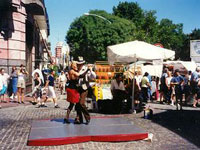
Plaza Dorrego lies in San Telmo, the bohemian artists' quarter of Buenos Aires and the birthplace of tango. The tiny square is surrounded by elegant houses, now mostly converted into antique shops and bars whose tables overflow onto the street. There are numerous museums nearby the Plaza Dorrego worth visiting, including the Museo Histórico Nacional and the Museo de Arte Moderno.On Sundays, the plaza is the setting for the ancient flea market, the Feria de San Pedro Telmo. Though you are unlikely to discover too many bargains, you may find an interesting souvenir or two. Once the stallholders pack up their wares at 5pm, the square becomes a stage for informal tango dancing. This is as popular with the locals as it is with tourists, and even the inexperienced may be tempted to try it out.Aside from the museums, flea markets and dancers, another of the square's main attractions is simply the people watching. Visitors to Buenos Aires will not regret an afternoon spent whiling away the hours at a sidewalk cafe, soaking in the atmosphere and admiring the passers-by until the dancers arrive for the evening's festivities.
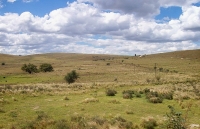
The vast flat plains of the Pampas are Argentina's agricultural heartland and the birthplace of the gaucho (cowboy). Lying southwest of Buenos Aires is the location of Argentina's famous beef and grain industry, the source of the country's wealth. The area is festooned with small agricultural towns, which are home to the majority of Argentina's population.The area provides some of the best horseback riding in the world, and excursions are available to different ranches where visitors can feast on asado after a day's horse riding. Visitors to the area can also attend a doma, a gaucho gathering held every Sunday. The domas consist of rodeo-like events, horse racing, and other games and competitions, as well as a market of stalls selling gaucho-inspired crafts.There are also some interesting animals that live only on the pampas, including the rhea (a large flightless bird, similar to an emu or ostrich), the pampas deer, the pampas fox, several armadillo species, the white-eared opossum, the Elegant Crested Tinamou, and more.
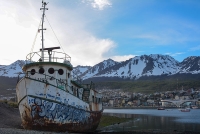
This island territory at the tip of South America is shared by Chile and Argentina and is a place of staggering scenery. Though further south, the region does not reach the extreme temperatures of neighbouring Patagonia, but it is still not for the faint-hearted. The principal tourist destination is Ushuaia, which acts as a base for those visiting the dramatic Canal Beagle, or trekking in the Parque Nacional Tierra del Fuego and the mountain ranges of southern Tierra del Fuego, with its magnificent scenery of lakes, snow-capped mountains and beechwood forests.Ushuaia is also the place to go if you want to visit Antarctica, since many ships depart from there on journeys stopping at several islands and taking in penguin colonies, seal and sea lion colonies, massive sea bird colonies, and more. The Les Eclaireurs Lighthouse is another attraction found in Ushuaia, and the area plays host to a few small ski resorts, featuring both downhill and cross-country skiing. There is less reason to visit the north of the island unless you are a keen fly-fishermen heading to the Río Grande, the world's best brown-trout river.
Website : http://www.tierradelfuego.org.ar/

Travel Guide powered by Word Travels, copyright © 2023 Globe Media Ltd. By its very nature information in this travel guide is subject to change at short notice and travellers are urged to verify information on which they're relying with the relevant authorities. Neither Globe Media Ltd nor Travel Vogue can accept any responsibility for any loss or inconvenience to any person as a result of information contained above.